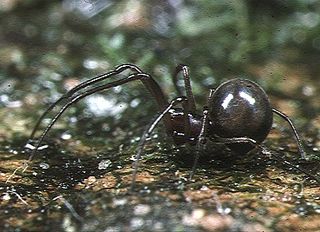
Anapidae is a family of rather small spiders with 231 described species in 58 genera. It includes the former family Micropholcommatidae as the subfamily Micropholcommatinae, and the former family Holarchaeidae. Most species are less than 2 millimetres (0.079 in) long.

Archaeidae, also known as assassin spiders and pelican spiders, is a spider family with about ninety described species in five genera. It contains small spiders, ranging from 2 to 8 millimetres long, that prey exclusively on other spiders. They are unusual in that they have "necks", ranging from long and slender to short and fat. The name "pelican spider" refers to these elongated jaws and necks used to catch their prey. Living species of Archaeidae occur in South Africa, Madagascar and Australia, with the sister family Mecysmaucheniidae occurring in southern South America and New Zealand.

Holarchaea is a genus of South Pacific araneomorph spiders in the family Anapidae, and was first described by Raymond Robert Forster in 1955. As of May 2019 it contains only two species, H. globosa and H. novaeseelandiae, but there may still be undescribed species in New Zealand.
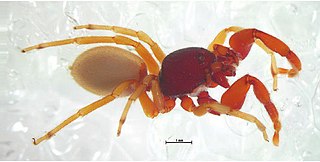
The Palpimanoidea or palpimanoids, also known as assassin spiders, are a group of araneomorph spiders, originally treated as a superfamily. As with many such groups, its circumscription has varied. As of September 2018, the following five families were included:
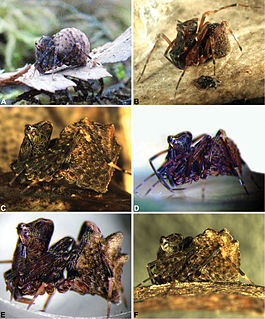
Zephyrarchaea is a genus of Australian assassin spiders first described by Michael Gordon Rix & Mark Harvey in 2012 for nine new species and two that were formerly placed in the genus Austrarchaea. The name is based on the Latin zephyrus, meaning "west wind", referring to the western distribution in Australia and a preference for windy, coastal habitats by some species. It has been encountered in Western Australia, Victoria and South Australia.
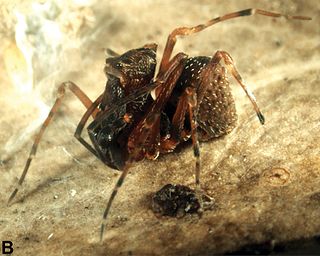
Zephyrarchaea barrettae is a species of spider of the family Archaeidae. The Latin species name was chosen to honor Sarah Barrett, who first discovered assassin spiders in the Stirling Range National Park.
Austrarchaea binfordae is a species of spider in the genus Austrarchaea. It was described by Rix & Harvey in 2011 after being identified in New South Wales, Australia. It is named for the US arachnologist, Greta Binford.
Greta J. Binford is a United States arachnologist, specialising in studies of spider venom. She is a Professor of Biology at Lewis & Clark College in Portland, Oregon.

Austrarchaea is a genus of Australian assassin spiders first described by Raymond Robert Forster & Norman I. Platnick in 1984.
Raveniella is a genus of spiders in the family Anapidae. It was first described in 2010 by Rix & Harvey. As of 2017, it contains 9 Australian species.
Ozarchaea is a genus of South Pacific shield spiders that was first described by Michael Gordon Rix in 2006.
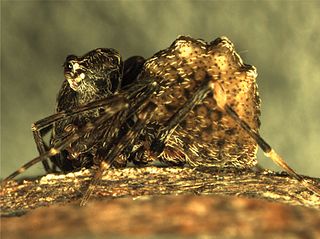
Zephyrarchaea mainae is a species of spider, informally known as Main's assassin spider, Albany assassin spider, and the Western archaeid spider. The first of the assassin spider family found in Western Australia, the species was unknown until its collection at Torndirrup National Park near Albany was published in 1987.
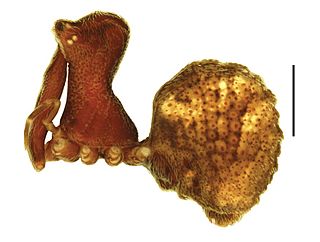
Zephyrarchaea grayi, also known as the Grampians Assassin Spider, is a species of spider in the family Archaeidae. It is endemic to Grampians National Park in Australia.

Zephyrarchaea marae, the West Gippsland assassin spider, is a spider in the family Archaeidae. The species was first described by Michael G. Rix and Mark Harvey in 2012. It is endemic to Victoria in Australia.
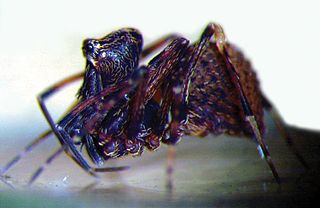
Zephyrarchaea marki, the Cape Le Grand assassin spider, is a spider in the family Archaeidae. The species was first described by Michael G. Rix and Mark Harvey in 2012. It is endemic to Cape Le Grand National Park in Australia.

The Otway Range Assassin Spider(Zephyrarchaea porchi) is a species of spider in the family Archaeidae. It is endemic to Victoria, Australia.

Zephyrarchaea vichickmani, the Central Highlands assassin spider, is a spider in the family Archaeidae. The species was first described by Michael G. Rix and Mark Harvey in 2012. It is endemic to Victoria, Australia.
Zephyrarchaea austini or the Kangaroo Island assassin spider is a species of Australian assassin spiders that is endemic to the north west of Kangaroo Island. It was discovered in 2010, and described 2012 by Michael G. Rix and Mark Harvey, and named for Andy Austin.













